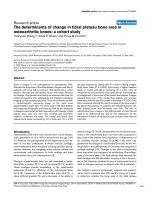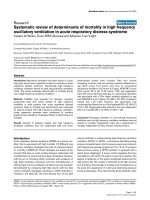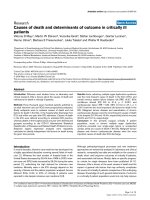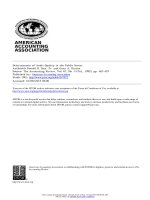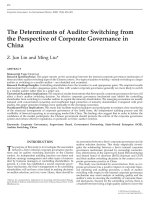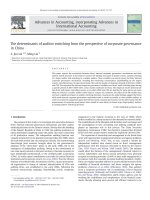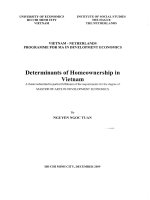Determinants of the loyalty of employees in businesses
Bạn đang xem bản rút gọn của tài liệu. Xem và tải ngay bản đầy đủ của tài liệu tại đây (799.86 KB, 64 trang )
1
Advisor’s assessment
Advisor’s signature
2
Table of contents
Chapter 1: Introduction 4
1.1. Problem statement 4
1.2. Research objectives 6
1.3. Research questions 6
1.4. Research scope 6
1.5. Research methodology 7
1.6. Research structure 8
Chapter 2: Literature Review 9
2.1. Theoretical literature 9
2.1.1. Approaches in the study of the loyalty of employees 9
2.1.2. Benefits of building and maintaining the loyalty of employees 10
2.2. Empirical literature 11
Chapter 3: Research Methodology 14
3.1. Data sources 14
3.1.1. Qualitative study 14
3.1.2. Quantitative study 15
3.2. Variables 15
3.3. Research model 19
3
3.4. Method of estimation 21
3.5. Method of testing 22
Chapter 4: Research Results 23
4.1. Synthesis of the survey result 23
4.2. Descriptive statistics 26
4.3. Adjustment of scale 28
4.4. Factor analysis 30
4.5. Adjusted model 33
4.6. Testing of the adjusted model 35
4.7. Result of testing hypothesis 40
4.8. Testing the loyalty rate between male and female 42
4.9. Testing the loyalty among employees at different levels 43
4.10. Testing the loyalty among employees at different positions 45
4.11. Testing the loyalty among employees in different business types 47
Chapter 5: Conclusion, Recommendation and Limitation 50
5.1. Performance and topic’s contributions 50
5.2. Practical signification and recommendation 52
5.3. Limitation and direction for coming studies 55
References 58
4
CHAPTER 1: INTRODUCTION
1.1. Problem statement:
Today, in the harsh conditions of the market, competition for human resources has
always been a hot issue in the company. And so, to attract talent, companies
constantly improve their policies of development of human resources under which
compensations and benefits, and many other treatment regimes are always
particularly interested by the company leaders.
Human resources management (HRM) issues include aspects: attendance, payroll,
screening, hiring, training, coaching, evaluating the work of staff, drafting the
remuneration policy, the labor remuneration regime, etc. But one of the most
important issues that should not be ignored by HRM professionals is the planning
and implementation of strategic development of human resources, attracting talent
to work for the company as well as not making them anxious with their thought
“the grass is always greener on the other side of the fence”.
According to results from a recent study by Walker Information and
Hodson Institute that provided some information about the loyalty of workers in
organizations as follows:
Only 24% of employees found that they were really loyal, true commitment
of contribution to the objectives and activities of the company, and available to
work for the firms in at least two years.
33% of employees had no commitment, no plan to survive in the firms in the
long term.
5
Up to 39% of employees have to be seen as being reluctant to work. They
worked only for a few specific reasons (wages, favoritism, waiting to find
another job, etc.) but did not have a specific plan to benefit to the businesses.
All business owners will admit that they have to always pay very high prices for the
leave of key employees. One of the problems often seen is the leave of the key
employees will entail the leave of key customers. The study showed that 70% of
customers leave because of the leave of key staff. Moreover, if there is continuous
passing of the key staff, it may cause underground waves of exit of all staff
remaining.
Currently, the problem of how to retain employees is a headache for business
owners and managers of enterprises in Vietnam. Especially after Vietnam joined
the WTO, the domestic enterprises need to expand production and business; in
addition to the need of high quality of human resources, they also have to know
how to retain qualified employees. It’s a matter of business survival. Thus, the
business must identify, consider and evaluate accurately factors that affect the
loyalty of employees, on the basis that the business will have appropriate direction
in the management of human resources, in order to have positive move to retain
talent for the business to avoid brain drain phenomenon in the future. That's why I
chose the topic “Determinants of the loyalty of employees in businesses”.
The paper attempts to identify the most important determinants of the loyalty of
employees and provide an integrated analysis on the identified determinants.
6
1.2. Research objectives:
The general objective of this study is to identify factors which affect the loyalty of
employees in businesses in Ho Chi Minh (HCM) city.
To achieve the general objective, the study is designed to meet the following specific
objectives:
(1) Find out determinants of the loyalty of employees in businesses in HCM city.
(2) Suggest implications to improve the management of human resources of the
businesses.
1.3. Research questions:
The research aims to address the following questions:
(1) What are the determinants of the loyalty of employees in businesses in HCM
city?
(2) What suggestions can this study have to improve the loyalty of employees in
businesses in HCM city?
1.4. Research scope:
Research objects who are currently working in the economic organizations;
including Limited Liability Company, Joint Stock Company, State-owned
Company, Joint Venture Company, Private enterprise and Enterprise 100% foreign
capital.
Since the time constraint, the study is focused on investigating the objects who are
currently working in businesses in HCM city in positions of staff, team leaders,
supervisors and middle managers.
7
1.5. Research methodology:
The research is conducted over 2 phases:
Phase 1: using qualitative research methods to confirm and supplement the
criteria of assessment, adjust scales and questionnaires to support the quantitative
research process.
Phase 2: using quantitative research methods, using the measured variables in
qualitative research phase to determine the factors and the measurement properties;
after adjustment, final scale is used for formal interview.
Samples and sample information: Quantitative survey was conducted in the area of
HCM city. Sample objects are currently working in businesses in HCM city,
conducted by direct interviews with the questionnaires, selecting a random sample
of students in night classes (in-service, degree 2, master, etc.) at some universities
in HCM city like University of Economics HCM City, Open University of HCM
City, University of Natural Sciences, University of Social Sciences and
Humanities, University of Industry, etc. Measurement model included 29 observed
variables, using 5-level Likert scale range (1: totally disagree to 5: completely
agree) to quantify; and 7 hypotheses according to minimum rule 5 x 3 = 15 samples
for each measurement variables (Bentle & Chou, 1987). So that the original sample
was calculated: 29 x 15 = 435.
Collecting and analyzing data: Using data processing techniques by SPSS software,
testing conducted through the following steps: (1) preliminary assessment of the
scale and reliability of variables measured by Cronbach Alpha coefficients, and the
values (factor loading) by EFA (Exploratory Factor Analysis); (2) testing the
hypothesis and the overall model fit. After that, T-Test would be used for testing
8
and ANOVA (Analysis of Variance) would be used for analyzing to find out
significant differences of a few specific groups.
1.6. Research structure:
Chapter 1: Introduction
Chapter 2: Literature review
Chapter 3: Research methodology
Chapter 4: Empirical results and discussion
Chapter 5: Conclusion, recommendation and limitation
9
CHAPTER 2: LITERATURE REVIEW
2.1. Theoretical literature:
2.1.1. Approaches in the study of the loyalty of employees:
There are many approaches in the study of the loyalty of employees in businesses.
Loyalty can be considered as a component of organizational commitment, or an
independent concept. Allen & Mayer (1990) focused on three psychological states
of employees associated with the organization. Employee loyalty to the
organization can derive from their true feelings: (1) they will stay with the
organization despite elsewhere higher salaries, better working conditions, (2) they
can be loyal to their organizations just because they do not have the opportunity to
earn a better job, and (3) they can be loyal to their organizations because the moral
standards of the organizations that they pursue.
According to Mowday, Steers and Poter (1979), loyalty is the "intention or desire to
maintain membership of the organization". Mowday's famous definition of loyalty
is similar to the concept of "Maintain" in the research of Aon Consulting Institute
for many years in US: employees who intend to stay with the organization in the
long term will stay with the organization even though they get more relatively
attractive offers from other organizations. According to Johnson (2005), today
employees are more loyal to their profession than loyal to their employer; and the
nature of the relationship between employees and employers has changed
fundamentally, and it is necessary to revaluate the loyalty concepts.
By the Loyalty Research Center (2004), employee loyalty is as commitment of
employees associated with the organization's success, and they believe that working
for this organization is the best choice of them. According to the scale model of
10
employee loyalty of Man Power (2002), the evaluation criteria of loyalty include:
(1) be willing to recommend their company as a good place to work; (2) be willing
to introduce the products and services of the company; and (3) Intend long-term
commitment to the company.
In the scope of this study, definition of Mowday et al. (1979) and the scale of
employee loyalty of Man Power (2002) are used.
2.1.2. Benefits of building and maintaining the loyalty of employees:
The value of employee loyalty is extremely large, reducing employee turnover cost
is just one visible example; and the benefit of retaining experienced and reliable
staff is invaluable. Seniority, experience and stability of the organization will be the
things we think of first, but beyond the personal experience will give us an
overview of the benefits to the organization of the construction and maintenance of
employee loyalty in today's economic situation.
On the revenue side: The loyal employees tend to work better than what
customers expect and always have high morale in their best ability. Both of
these characteristics are very important for the company to retain loyal
customers and bring in more sales.
On the expense side: The loyal employees will stay working with the
company in long term, refuse offers from the opponents, not actively look for a
new job and always present the company as a good workplace. All four of these
attitudes have a positive impact to the operating cost of the company, because
the company will avoid a significant cost for replacing staff.
In other words, instead of just focusing on holding the employees (try to keep the
employees who were laid off), managers need to be more positive and proactive in
11
recognizing the benefits of understanding, managing and enhancing the loyalty of
employees.
Thus, despite the loyalty of employees is recognized as one of the factors which is
most crucial to the success of the business, it is not surprising to note that
companies are facing with the critical challenges in developing a team of
enthusiastic and dedicated.
2.2. Empirical literature:
Herzberg (1968):
In this study, Herzberg interviewed a group of employees to find out what made them
satisfied and dissatisfied on the job. He revealed two important factors that affect job
satisfaction: motivation and hygiene. Motivation – hygiene theory factors pointed out
that factors creating of job satisfaction and job dissatisfaction were separate. Factors
that led to job satisfaction are called motivation factors, including achievement,
recognition, the work itself, responsibility and advancement. Factors that led to job
dissatisfaction are called hygiene factors, consisting of administrative policies,
supervision, salary, interpersonal relations and working conditions. Herzberg’s study
had put a strong foundation for later research on factors affecting job satisfaction.
Albert S. King and Barbara J. Ehrhard (1997):
In their study, they described the commitment cohesion exercise, which is an
instrument that increases the understanding of employees’ attraction to “the ideal” or
empowered organization. The exercise measures employees’ perception of loyalty,
values, and organizational commitment. Three conditions, i.e. loyalty, values and
commitment, influence empowerment structures within an organization. The exercise
supported the notion of a stepwise movement from loyalty to value congruence (or
12
agreement) to organizational commitment. It also demonstrated how progressive
phases are associated with perceived quality of work life and connected to an
empowered organization.
Zhen Xiong Chen, Anne S. Tsui and Jiing-Lih Larry Farh (2002):
In this research, they investigated the relationship between loyalty to supervisor and
employee's in-role and extra-role performance in comparison with that of
organizational commitment in the People's Republic of China. Two studies were
conducted. In the first study, a five-dimension loyalty to supervisor scale was
developed and validated. In the second study, the relationships between loyalty to
supervisor, organizational commitment and employee performance were examined.
Results indicated that loyalty to supervisor was more strongly associated with both in-
role and extra-role performance than organizational commitment.
Frederick Reichheld (2006):
In his study, he reported that loyalty, for those who plan to stay with an employer at
least two years, can be affected by several factors, including benefits and pay, working
environment, job satisfaction and customers. Employee loyalty is critical for
organizations as constant turnover or churn can be very expensive. In his report he
stated that one of the most effective ways to improve employee loyalty is to make
employees feel like they are an important part of the organization. His report found
that only 55 percent of the employee surveyed feel like their organization treats them
well. He suggested that an employee feedback system can help raise employee loyalty
by providing two-way communications between employees and management.
Artz (2010):
13
According to the results of Artz’s study, fringe benefits are significant and positive
determinants of job satisfaction. Fringe benefits are also believed to have a profound
impact on the loyalty of employees. It plays as a motivator that helps to improve
employee performance and reduce employee turnover.
In summary, there are many studies on employee loyalty to the organization, but
most previous studies only focused on a general way to a certain extent, such as
organizational culture, leadership style, etc. There is now no study has ever addressed
the specific factors affecting the loyalty of employees. Therefore in this study each
specific factor such as salary, working conditions, the appropriate target, etc. will be
examined to find out how each of them will affect the loyalty of employees in
businesses.
14
CHAPTER 3: RESEARCH METHODOLOGY
3.1. Data sources:
3.1.1. Qualitative study:
The first step of qualitative research is to adjust the scale. The variables are
adjusted and supplemented in accordance with the form of bipartite discussions
under a pre-prepared content based on the available scales. The content of
discussions will be recorded, synthesized as a basis for the adjustment and addition
of variables.
Objectives:
Determine how managers of human resource understand the expectation of
staff? In their opinion, what are the factors that make staff more loyal to the
organization?
Determine what is expected by staff in the organization? Which elements
make them more loyal to the organization?
Interviews:
Management level: Human resources managers of FedEx Representative
Office and Kinh Do Corporation were interviewed.
Staff level: 20 employees of different departments of FedEx Representative
Office were interviewed. And 20 employees of different departments of Kinh
Do Corporation were interviewed.
The results of this preliminary research shall be used to design the questions for the
official research.
15
3.1.2. Quantitative study:
This is the stage of formal study with data collection techniques of interviewing
through a questionnaire. The collected data is processed by SPSS software. After
encoding and cleansing date, the formal analysis will be implemented as follows:
Assess the reliability of the scale: the reliability of the scale was assessed
through Cronbach’s alpha coefficients, from which inappropriate variables will
be eliminated if the Corrected Item–Total Correlation is small (<0.3) and the
scale will be accepted as Cronbach’s alpha coefficient is satisfactory (> 0.6).
Then, analyze the factor will be used to test the convergence of the component
variables of the concept. The variables with a singular correlation coefficient
between variables and other factors (factor loading) less than 0.5 will be
disqualified. Analytical methods of Principal axis factoring with Promax
rotation will be done and stops when extracting factors of Eigenvalue greater
than 1.
Finally, test the hypothesis of a structural model and the level which fit the
overall model.
3.2. Variables:
(1) High income / salary:
Remuneration has always been one of the most challenging issues for managers in
every business. Businesses often have multiple points of view, different goals when
designing their remuneration system. However businesses generally are oriented to the
four basic objectives: to attract staff, to maintain good staff, to stimulate employee
motivation and to meet the requirements of the law.
16
For most people, employment and quality of employment are often measured by the
income of the job. Thus, income is considered as a measure of work as well as the
success of the employee at work. High income makes people more satisfied at least in
term of physical secure so that they pay more attention to work and try to prove their
worth even more. Therefore, it makes an enormous impact on the morale of
employees. This impact is reflected in the following aspects:
When the employees earn and feel worthy of their dedication, they will be
enthusiastically excited at work.
They have little intention of leaving the company for another job while they are
satisfied with their current income.
They are more responsible for the work they are in charge.
They have more discipline in observing the rules of the company.
So the hypothesis is set out:
H1: High income / salary will make employees more loyal to the businesses.
(2) Favorable working conditions
The working environment has always been interested by workers because it is related
to personal convenience and it is also a factor which makes them complete the tasks.
Workers do not like the working environment dangerous, disadvantageous and
inconvenient. Temperature, light, noise and other environmental conditions must be
consistent. Moreover, many workers prefer working closer to home, with the working
facilities clean, modern and appropriate. (Lam, 1998)
So we hypothesize that:
17
H2: Favorable working conditions will make employees more loyal to the businesses.
(3) Target suitability
Targets are considered suitable when employees realized their goals and values are
relevant to their commitment to the goals and values of the company. The target
suitability is similar to the concept of the suitability of individual - organization, which
is defined as the compatibility of personal values and beliefs with the rules and values
of the organization (O’Reilly et al., 1991). The suitability of individual – organization
is the basis of the most important prediction of many factors to be studied (Chatman,
1991; Kristof, 1996; Van Vianen, 2000).
Research in sales planning indicated that the target is a prerequisite for a positive
working attitude and employee behaviors (Netemeyer et al., 1997). Commitment to the
goals and values of the organization plays an important role in the service and retail
sectors. The implementation of the policies and activities of an organization related to
services require the commitment of employees to its goals and values.
Therefore we hypothesize that:
H3: Target suitability will make employees more loyal to the businesses.
(4) Support from management
Support from the management is the central focus of many researches. Support from
the management is defined as the level of consideration and support that employees
can receive from the supervisors (Netemeyer et al., 1997). Leaders must have ability to
help and treat employees fairly, encourage two-way communication, and recognize the
contribution of the employees to implement the goals of the organization.
Therefore the hypothesis is set out:
18
H4: Support from management will make employees more loyal to the businesses.
(5) Support from colleagues
Support from the colleagues will help employees, especially newcomers, learn new
skills and knowledge. It will help promote the business, increase the productivity and
decrease time and energy wastage. The term "knowledge is power" is antiquated in a
team environment, knowledge should be shared so the team can work well together,
learn from each other and respect each other's views and ideas.
So we hypothesize that:
H5: Support from colleagues will make employees more loyal to the businesses.
(6) Fair reward
Fair reward exists when employees are rewarded worthily with their work pressure and
achievement (Netemeyer et al., 1997). Reward fairness is based on the concept of fair
distribution (Lane & Messe, 1971). The concept of fairness contained both fairness in
distribution and procedure. Previous studies indicated that the fair distribution in
related to employment relationship is more important than fair procedure.
Fairness theory pointed out each individual follows a particular rule of fairness
governing their attitudes and behaviors (Lane & Messe, 1971). This suggests that
employees who are rewarded fairly will have a more positive perspective and
willingness to act in the direction of supporting businesses.
Thus we hypothesize that:
H6: Fair reward will make employees more loyal to the businesses.
(7) Empowerment
19
Empowerment exists when supervisors believe in the ability of making decisions of
employees and encourage them to use initiative (Conger & Kanungo, 1998; Hartline et
al., 2000). Empowerment means nearly autonomous tasks. Core of this concept is the
willingness of supervisors to subordinates to make decisions within the scope of
regulation and use initiative. Empowerment can be a tool to increase organizational
effectiveness because it can enhance confidence in the ability to perform the
employee's job. Empowerment is particularly important for employees who contact
directly with customers because it creates flexibility in meeting customer requirements
(Bowen & Lawler, 1992).
Thus the hypothesis is set out:
H7: Empowerment will make employees more loyal to the businesses.
3.3. Research model:
This study uses a linear regression model to test the influence of the determinants on
the loyalty of employees in businesses.
Loyalty = β0 + β1*High income + β2* Favorable working conditions + β3* Target
suitability + β4* Support from management + β5* Support from colleagues + β6* Fair
reward + β7* Empowerment + ε
20
High income
Target suitability
Loyalty of
employees
Favorable working
conditions
Support from
management
Support from
colleagues
Fair reward
Empowerment
21
3.4. Method of estimation:
Sampling frame: Sampling frame is a part of the overall, which is selected for
observation. Sampling frame of the research is limited in HCM city.
Method of choosing sample: There are two methods of choosing sample:
probability sampling and non-probability sampling. Probability sampling method is
the one in which researchers know the probability of participation in the form of the
element. The non-probability sampling method is the one to select elements
involved in randomly irregular patterns. In this study, probability sampling method
is used.
Dimension of sample: There are 7 hypotheses and 29 observed variables which
were identified. Likert 5 scale is used. Therefore, according to minimum rule, there
are 5 x 3 = 15 samples for each measurement variables (Bentle & Chou, 1987). So
that the original sample are calculated: 29 x 15 = 435.
Method of taking sample: Selecting a random sample of students in night classes
(in-service, degree 2, master, etc.) at some universities in HCM city like University
of Economics HCM City, Open University of HCM City, University of Natural
Sciences, University of Social Sciences and Humanities, University of Industry,
etc.
Result and information of sample: Detailed questionnaire is presented in
Appendix A. There were 600 questionnaires which were sent directly to the object
of study. During the survey process, there are some groups who have not worked
and in a number of questionnaires some row were left unanswered. All these
questionnaires are to be removed prior to data entry. Therefore, the number of
formal questionnaire was conducted to analyze input only remaining 453 sets,
accounting for 76% of the sent questions.
22
3.5. Method of testing:
Using data processing techniques using SPSS 11.5 software, testing through the
following steps:
Preliminary assessment of the scale and reliability of variables measured by
Cronbach’s alpha coefficients, and the values (factor loading) by EFA (Exploratory
Factor Analysis).
Testing the hypothesis of a structural model and the overall model fit. Next,
performing ANOVA & T-Test between among different groups with structure
model inspected to find out the meaning difference of some certain groups.
23
CHAPTER 4: RESEARCH RESULTS
4.1. Synthesis of the survey result:
4.1.1. Survey result of gender:
The total number of female is 283, accounting for 62.5% and the total number of
male is 170, accounting for 37.5%.
Table 4.1: Survey result of staff on gender
Fr
equency
P
e
r
cent
V
alid
P
e
r
cent
Cumulative
P
e
r
cent
V
alid Female
Male
Total
283
170
453
62.5
37.5
100.0
62.5
37.5
100.0
62.5
100.0
4.1.2. Survey result of age:
The greatest number is of between 21-30 years old with 351 people, accounting for
77.5% (including 241 female and 110 male). The later is of 31-40 years old, with
90 people, accounting for 19.9% (including 36 female and 54 male). The remaining
two age groups <20 and >40 occupy a small amount of 12 people.
24
Table 4.2: Survey result of staff on age
Gender
Group total
Female
Male
Count
Col %
Count
Col %
Count
Col %
Age
<20
2
0.7%
2
0.4%
21 - 30
241
85.2%
110
64.7%
351
77.5%
31 - 40
36
12.7%
54
31.8%
90
19.9%
>40
4
1.4%
6
3.5%
10
2.2%
Group total
283
100.0%
170
100.0%
453
100.0%
4.1.3. Survey result of education level:
The largest number is of staff with university degree, 274 people, and occupying
60.5% (in which 155 female and 119 male). Next, those with college degree are of
about 83 people, occupying approximately 18.3% (in which 67 female and 16
male). Followed by those with an intermediate level, there are 53 people,
occupying approximately 11.7% (in which 39 female and 14 male). Followed by
those with a high school degree, there are 35 people, accounting for approximately
7.7% (in which 20 female and 15 male). The last group includes staff who have
higher degree, 8 people (2 female and 6 male), accounting for approximately 1.8%.
Table 4.3: Survey result of staff on education level
Gender
Group total
Female
Male
Count
Col %
Count
Col %
Count
Col %
Level
High school
20
7.1%
15
8.8%
35
7.7%
Intermediate
39
13.8%
14
8.2%
53
11.7%
College
67
23.7%
16
9.4%
83
18.3%
University
Higher degree
155
2
54.8%
0.7%
119
6
70.0%
3.5%
274
8
60.5%
1.8%
Group total
283
100.0%
170
100.0%
453
100.0%
25
4.1.4. Survey result of working position:
The largest group is of employees working as staff with about 313 people,
accounting for 69.1% (in which 223 female and 90 male). Next, the team
leader/expert group has about 84 people, occupying approximately 18.5% (in which
40 female and 44 male). There are 56 managers, accounting for 12.4% (in which 20
female and 36 male).
Table 4.4: Survey result of staff on working position
Gender
Group total
Female
Male
Count
Col
%
Count
Col
%
Count
Col
%
Working
position
Staff
Leader
Manager
223
40
20
78.8%
14.1%
7.1%
90
44
36
52.9%
25.9%
21.2%
313
84
56
69.1%
18.5%
12.4%
Group total
283
100.0%
170
100.0%
453
100.0%
4.1.5. Survey result of business type:
The largest group is of employees who are working for the joint stock companies,
with 130 people, accounting for 28.7% (including 76 female and 54 male). Next
group is of employees who are working for limited liability companies, with 125
people, occupying approximately 27.6% (including 94 female and 31 male). The
number of employees working for state-owned companies and private companies
are as large as 72 people of each, accounting for about 15.9% of each. Number of
employees who are working for enterprises with 100% foreign capital are 28,
accounting for 6.2%. And the last, number of employees who are working in joint
ventures are 26, occupying approximately 11.7%.

